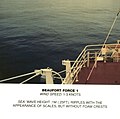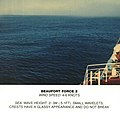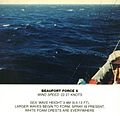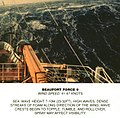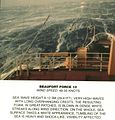Beaufort scale
The Beaufort scale is a scale for measuring wind speeds. It is based on observation rather than accurate measurement. It is the most widely used system to measure wind speed today. The scale was developed in 1805 by Francis Beaufort, an officer of the Royal Navy and first officially used by HMS Beagle.
There are twelve levels, plus 0 for "no wind". From 1946 to 1970, there were also beaufort levels 13 to 17. All of them were labelled as Hurricane. Because they were only used in special cases, they are no longer in use internationally. China, and Taiwan still use them, because they often have typhoons.
The wave heights given are for waves on the open ocean, not near the shore.
The Douglas Sea Scale and Douglas Wind Scale are similar, but they separate the sea from the wind.
The scale
| Beaufort number | Symbol | Wind speed | Description | Wave height | What the sea looks like | What it looks like on land | Sea state photo | ||||
|---|---|---|---|---|---|---|---|---|---|---|---|
| km/h | mph | kts | m/s | m | ft | ||||||
| 0 |  | <1 | <1 | Calm | 0 | 0 | Flat and little movement. | Calm. Smoke rises vertically. |  | ||
| 1 |  | 1-3 | 1-3 | Light air | 0.1 | 0.33 | Ripples without crests. | Wind motion visible in smoke. |  | ||
| 2 |  | 3-7 | 4-6 | Light breeze | 0.2 | 0.66 | Small wavelets. Crests of glassy appearance, not breaking | Wind felt on exposed skin. Leaves rustle. |  | ||
| 3 |  | 8-12 | 7-10 | Gentle breeze | 0.6 | 2 | Large wavelets. Crests begin to break; scattered whitecaps | Leaves and smaller twigs in constant motion. |  | ||
| 4 |  | 13-17 | 11-16 | Moderate breeze | 1 | 3.3 | Small waves. | Dust and loose paper raised. Small branches begin to move. |  | ||
| 5 |  | 18-24 | 17-21 | Fresh breeze | 2 | 6.6 | Moderate (1.2 m) longer waves. Some foam and spray. | Branches of a moderate size move. Small trees begin to sway. |  | ||
| 6 |  | 25-30 | 22-27 | Strong breeze | 3 | 9.9 | Large waves with foam crests and some spray. | Large branches in motion. Whistling heard in overhead wires. Umbrella use becomes difficult. Empty plastic garbage cans tip over. |  | ||
| 7 |  | 31-38 | 28-33 | High wind, Moderate Gale, Near Gale | 4 | 13.1 | Sea heaps up and foam begins to streak. | Whole trees in motion. Effort needed to walk against the wind. Swaying of skyscrapers may be felt, especially by people on upper floors. |  | ||
| 8 |  | 39-46 | 34-40 | Fresh Gale | 5.5 | 18 | Moderately high waves with breaking crests forming spindrift. Streaks of foam. | Twigs broken from trees. Cars veer on road. |  | ||
| 9 |  | 47-54 | 41-47 | Strong Gale | 7 | 23 | High waves (6-7 m) with dense foam. Wave crests start to roll over. Considerable spray. | Larger branches break off trees, and some small trees blow over. Construction/temporary signs and barricades blow over. Damage to circus tents and canopies. |  | ||
| 10 |  | 55-63 | 48-55 | Whole Gale/Storm | 9 | 29.5 | Very high waves. Large patches of foam from wave crests give the sea a white appearance. Considerable tumbling of waves with heavy impact. Large amounts of airborne spray reduce visibility. | Trees are broken off or uprooted, saplings bent and deformed, poorly attached asphalt shingles and shingles in poor condition peel off roofs. |  | ||
| 11 |  | 64-72 | 56-63 | Violent storm | 11.5 | 37.7 | Exceptionally high waves. Very large patches of foam, driven before the wind, cover much of the sea surface. Very large amounts of airborne spray severely reduce visibility. | Widespread vegetation damage. More damage to most roofing surfaces, asphalt tiles that have curled up and/or fractured due to age may break away completely. |  | ||
| 12 |  | ≥73 | ≥64 | Hurricane-force | ≥14 | ≥46 | Huge waves. Sea is completely white with foam and spray. Air is filled with driving spray, greatly reducing visibility. | Considerable and widespread damage to vegetation, a few windows broken, structural damage to mobile homes and poorly constructed sheds and barns. Debris may be hurled about. |  | ||
Images
- 1 Beaufort
- 2 Beaufort
- 3 Beaufort
- 4 Beaufort
- 5 Beaufort
- 6 Beaufort
- 7 Beaufort
- 8 Beaufort
- 9 Beaufort
- 10 Beaufort
- 11 Beaufort
- 12 Beaufort
Other websites
- UK Meteorological Office: The Beaufort Scale
- Investigating Clouds Archived 2006-10-19 at the Wayback Machine a lesson plan from the National Science Digital Library that uses the Beaufort Scale.
- Radio interview with Scott Huler.
- OceanWeather.com gives current graphics for wind, waves and temperature
- Open Source Textbook at Oceanworld.tamu.edu Archived 2016-03-06 at the Wayback Machine [broken link] cites the original definition formula in chapter 4 Archived 2009-08-03 at the Wayback Machine
- Howtoon Poster Archived 2008-12-06 at the Wayback Machine showing effects on land/sea effects at each step.
